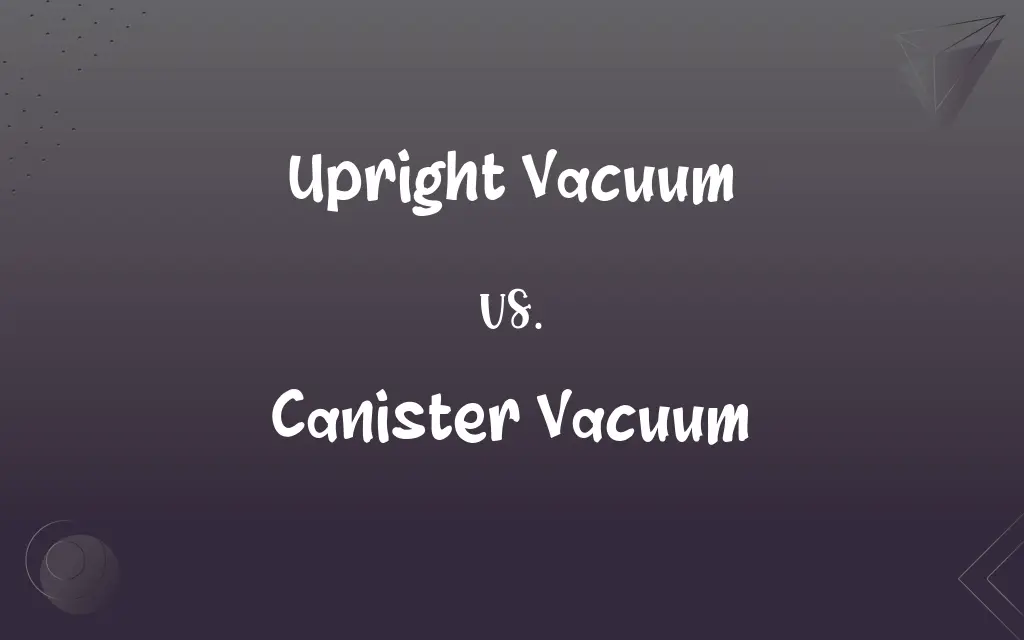Upright Vacuum vs. Canister Vacuum: What's the Difference?
Edited by Aimie Carlson || By Harlon Moss || Published on March 23, 2024
Upright vacuums have a single, tall unit for suction and handle, while canister vacuums consist of a wheeled body for suction connected by a hose to a separate wand.

Key Differences
Upright vacuums feature a design where the suction head and motor are part of the same unit the user pushes in front of them. This all-in-one design is popular for its ease of storage and straightforward use, especially on carpeted areas. Upright vacuums typically have a foot lever to change the angle for easier maneuverability. Canister vacuums, on the other hand, separate the motor and suction head, with the motor unit sitting on the ground. This design offers flexibility and ease of movement, allowing the user to clean hard-to-reach areas and stairs more easily.
Canister vacuums are known for their versatility, as they often come with various attachments for different surfaces and are generally considered better for hard floors. They can be easier to handle due to their lighter wand, making them suitable for cleaning drapes, upholstery, and under furniture. Uprights usually have a beater bar, making them more effective on carpets for removing pet hair and deep-seated dirt. However, they can be heavier and harder to maneuver around tight spaces.
The noise level of upright vacuums can be higher compared to canister vacuums, due to the closer proximity of the motor unit to the user's ears during operation. Canister vacuums might offer a quieter cleaning experience, as the main unit can be placed further away from the user. This aspect is a consideration for those sensitive to noise or in environments where low noise is preferred.
Maintenance and cleaning of upright vacuums can be more straightforward, with many models featuring easy-to-empty dustbins and replaceable filters. Canister vacuums may require more steps to detach the hose or change bags, depending on the model. Yet, the flexibility of canister vacuums often translates to better overall cleaning capability, especially for multi-surface homes.
The choice between an upright and canister vacuum often comes down to personal preference, cleaning needs, and the layout of the home. Uprights might be preferred for larger, carpeted areas, while canisters could be the choice for homes with a variety of surfaces and more furniture.
ADVERTISEMENT
Comparison Chart
Design
All-in-one, with suction head part of the main unit.
Separate motor and suction head, connected by a hose.
Best For
Carpeted floors.
Hard floors and versatile cleaning (e.g., drapes, stairs).
Maneuverability
Less flexible, better for open areas.
More flexible, easier to handle in tight spaces.
Weight & Handling
Generally heavier, pushed in front.
Lighter wand, main unit on wheels.
Noise Level
Potentially louder, closer to user’s ears.
Potentially quieter, main unit can be placed away.
ADVERTISEMENT
Upright Vacuum and Canister Vacuum Definitions
Upright Vacuum
Often has a bagless design with easy-to-empty dustbins.
Emptying the dustbin of her upright vacuum was a breeze after a full house clean-up.
Canister Vacuum
Features a wheeled body for easy movement around the home.
He pulled the canister vacuum smoothly from room to room without lifting it.
Upright Vacuum
Typically heavier and ideal for larger, open areas.
Despite its weight, the upright vacuum easily cleaned the entire office floor.
Canister Vacuum
Generally quieter than upright models, with the motor unit placed away from the user.
The canister vacuum cleaned the library quietly, without disturbing anyone.
Upright Vacuum
An upright vacuum is a cleaning device with a vertical design that combines the suction head and motor in one unit.
She quickly finished vacuuming the living room carpet with her new upright vacuum.
Canister Vacuum
Ideal for hard floors and reaching under furniture with a flexible hose.
The canister vacuum's long hose made cleaning the hard-to-reach areas simple.
Upright Vacuum
Designed for efficient carpet cleaning with an integrated beater bar.
The upright vacuum's powerful brush roll made short work of the pet hair on the rug.
Canister Vacuum
Comes with various attachments for specialized cleaning tasks.
Using the brush attachment, the canister vacuum left the drapes dust-free.
Upright Vacuum
Features a foot lever to adjust the unit's angle for easier maneuverability.
He adjusted the upright vacuum's angle to reach under the coffee table effortlessly.
Canister Vacuum
A canister vacuum separates the motor and suction head, offering versatile cleaning.
She maneuvered the canister vacuum's lightweight wand under all the chairs effortlessly.
FAQs
What defines an upright vacuum?
A single, tall unit that combines suction and handle, ideal for carpets.
Which is better for carpet, upright or canister?
Uprights, with their beater bars, are typically better for carpets.
Are canister vacuums good for stairs?
Yes, their flexible hoses and lightweight wands make them ideal for stairs.
Which vacuum type is easier to store?
Upright vacuums, due to their all-in-one design, tend to be easier to store.
Are there bagless options for both vacuum types?
Yes, both types are available in bagless models.
Which vacuum type is quieter?
Canister vacuums are generally quieter than upright vacuums.
What defines a canister vacuum?
A wheeled body connected by a hose to a wand, versatile for various surfaces.
Can canister vacuums be used on carpets?
Yes, especially models with powerheads are effective on carpets.
Do canister vacuums have automatic cord rewind?
Many canister models feature automatic cord rewind for convenience.
Can I use a canister vacuum for upholstery?
Yes, they are excellent for upholstery, thanks to their attachments.
Which vacuum type is generally heavier?
Upright vacuums are generally heavier than canister vacuums.
Can both vacuum types handle pet hair?
Yes, but uprights with beater bars may have an edge on carpets.
Which type of vacuum offers more accessories?
Canister vacuums often come with a wider range of cleaning attachments.
How do I decide which vacuum type is right for me?
Consider your home’s layout, floor types, and specific cleaning needs.
Do both vacuum types come with HEPA filters?
Yes, many models of both types offer HEPA filtration options.
Do upright vacuums require more maintenance?
Maintenance depends on the model, but uprights may have simpler dustbin emptying.
Is there a performance difference on hard floors?
Canister vacuums are typically better suited for hard floors.
Is one type more expensive than the other?
Prices vary widely based on features and brands rather than type.
Are canister vacuums easier to maneuver?
Yes, due to their flexible hoses and separate wands.
Which type is better for large areas?
Upright vacuums are often preferred for larger, open areas.
About Author
Written by
Harlon MossHarlon is a seasoned quality moderator and accomplished content writer for Difference Wiki. An alumnus of the prestigious University of California, he earned his degree in Computer Science. Leveraging his academic background, Harlon brings a meticulous and informed perspective to his work, ensuring content accuracy and excellence.
Edited by
Aimie CarlsonAimie Carlson, holding a master's degree in English literature, is a fervent English language enthusiast. She lends her writing talents to Difference Wiki, a prominent website that specializes in comparisons, offering readers insightful analyses that both captivate and inform.































































